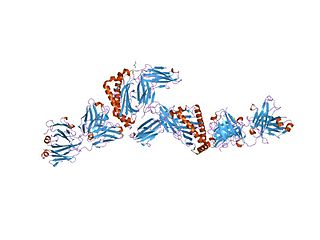
Melanoma-associated antigen 1 is a protein that in humans is encoded by the MAGEA1 gene.

Carcinoembryonic antigen-related cell adhesion molecule 1 (CEACAM1) also known as CD66a, is a human glycoprotein, and a member of the carcinoembryonic antigen (CEA) gene family.

Cancer/testis antigen 1 also known as LAGE2 or LAGE2B is a protein that in humans is encoded by the CTAG1B gene. It is most often referenced by its alias NY-ESO-1.

Melanoma-associated antigen 3 (MAGE-A3) is a protein that in humans is encoded by the MAGEA3 gene.

Melanoma-associated antigen D1 is a protein that in humans is encoded by the MAGED1 gene.

Melanoma-associated antigen 4 is a protein that in humans is encoded by the MAGEA4 gene.

Baculoviral IAP repeat-containing protein 7 is a protein that in humans is encoded by the BIRC7 gene.

L-myc-1 proto-oncogene protein is a protein that in humans is encoded by the MYCL1 gene.

Melanoma-associated antigen 2 is a protein that in humans is encoded by the MAGEA2 gene.

Melanoma-associated antigen C2 is a protein that in humans is encoded by the MAGEC2 gene.

Melanoma-associated antigen D2 is a protein that in humans is encoded by the MAGED2 gene.

Melanoma-associated antigen B2 is a protein that in humans is encoded by the MAGEB2 gene.

Melanoma-associated antigen H1 is a protein that in humans is encoded by the MAGEH1 gene.

Melanoma-associated antigen 11 is a protein that in humans is encoded by the MAGEA11 gene. It is also involved in the androgen and progesterone receptor signaling pathways.

Melanoma-associated antigen 12 is a protein that in humans is encoded by the MAGEA12 gene.

Melanoma-associated antigen D4 is a protein that in humans is encoded by the MAGED4B gene.

Melanoma-associated antigen 9 is a protein that in humans is encoded by the MAGEA9 gene.
Melanoma antigen family A, 5 is a protein in humans that is encoded by the MAGEA5 gene.

Melanoma antigen family A, 8 is a protein that in humans is encoded by the MAGEA8 gene.

MAGE family member D4 is a protein that in humans is encoded by the MAGED4 gene.










